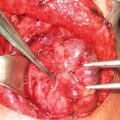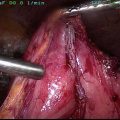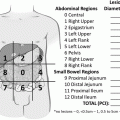Risk category
Age to begin
Recomm.
Comment
Personal history of <3 adenomas with low-grade dysplasia
5–10 years after the initial polypectomy
Colonoscopy
Examination interval should be based on other clinical factors such as prior examination findings, family history, or preferences of the endoscopist or patient
Personal history of 3–10 adenomas, or 1 adenoma >1 cm, or any adenoma with villous features or high-grade dysplasia
3 Years after the initial polypectomy
Colonoscopy
Adenomas require compete excision. If the follow-up is normal, the next examination should be in 5 years. More than 10 adenomas should raise the suspicion of a familial syndrome
Personal history of colorectal cancer
1 Year after resection
Colonoscopy
Patients should undergo high-quality preoperative clearing. Follow-up after normal examinations should be extended to 3 years, and then to 5 years
Family history of adenomas or cancer in a first-degree relative <60 years of age or in 2 first-degree relatives at any age
Age 40 years, or 10 years before the youngest case
Colonoscopy
Every 5 years
Family history of adenomas or cancer in a first-degree relative >60 years of age or in 2 second-degree relatives with cancer
Age 40 years
Colonoscopy
Screening should be initiated at an earlier age. Intervals based on findings or by the average risk patient
FAP or suspected FAP
Age 10–12 years
Annual FS, counseling for genetic testing if showing polyps
Colectomy should be considered for positive genetic testing
HNPCC or risk of HNPCC
Age 20–25 years, or 10 years before the youngest case
Colonoscopy, counseling for genetic testing
Every 1–2 years. Genetic testing should be offered to first-degree relatives of persons with a known DNA mismatch repair gene, or with 1 of the first 3 Bethesda criteria
IBD, Crohn’s or chronic UC
8 Years after the onset of pancolitis, or 12–15 years after the onset of left-sided colitis
Colonoscopies with random 4-quad biopsies every 10 cm for dysplasia
Screening should be offered every 1–2 years, and patients are best referred to a center with experience in the surveillance and management of IBD
Familial Colorectal Cancer Syndromes
Familial adenomatous polyposis (FAP) is an inherited, non-sex-linked, Mendelian dominant disease that accounts for approximately 1 % of all colorectal cancers. The high penetrance of FAP means that there is a 50 % chance of development within affected families. However, 20 % of FAP patients have no family history, likely representing new and spontaneous mutations. The disorder is due to mutations in either the tumor-suppressor APC gene, which is located on chromosome 5 (5q21-q22), or in the MUTYH gene, which is located on chromosome 1 (1p34.3-p32.1). FAP is characterized by the progressive development of hundreds or thousands of adenomatous polyps located throughout the entire colon. The clinical diagnosis is based on the histologic confirmation of at least 100 adenomas. All patients will eventually develop colorectal cancer. The adenomas generally appear by the mid-20s and cancers generally appear by the late-30s. An attenuated form of FAP is recognized in which fewer adenomas (20–100) are identified. Adenomas and cancers develop somewhat later, at the average ages of 44 and 56, respectively. FAP also exhibits extracolonic manifestations including gastric/duodenal/small bowel polyps, osteomas and desmoids tumors (Gardner’s syndrome), eye lesions such as congenital hypertrophy of retinal pigment epithelium (CHRPE), epidermoid cysts, and brain neoplasms (Turcot’s syndrome).
Hereditary nonpolyposis colon cancer (HNPCC), also called Lynch syndrome, is an inherited, non-sex-linked, Mendelian dominant disease wit h virtually complete penetrance. It is the most common genetic form of colorectal cancer and includes 2–4 % of all colorectal cancers [3, 4]. HNPCC is due to a defect in various DNA mismatch repair genes (MLH1, MSH2, MSH6, PMS, PMS2), which leads to microsatellite instability (MSI-H). A number of evidence-based criteria are available for the diagnosis of HNPCC, including the Amsterdam I and II criteria and the Bethesda guidelines (Table 2). According to the EPICOLON study, the revised Bethesda guidelines are the most discriminating set of clinical parameters for diagnosing HNPCC [5].
Table 2
Diagnosis of hereditary nonpolyposis colon cancer
Amsterdam I Criteria, 1990 |
1. Three or more family members with histologically verified colorectal cancer, one of whom is a first-degree relative (parent, child, sibling) of the other two |
2. Two successive affected generations |
3. One or more colon cancers diagnosed under age 50 years |
4. Familial adenomatous polyposis has been excluded |
Amsterdam II Criteria, 1999 |
1. Three or more family members with histologically verified HNPCC-related cancers (endometrium, ovary, stomach, small intestine, hepatobiliary, upper urinary tract, brain, and skin), one of whom is a first-degree relative (parent, child, sibling) of the other two |
2. Two successive affected generations |
3. One or more colon cancers diagnosed under age 50 years |
4. Familial adenomatous polyposis has been excluded |
Revised Bethesda Guidelines, 2002 |
1. Colorectal cancer diagnosed in a patient who is less than 50 years of age |
2. Presence of a synchronous, metachronous colorectal, or other HNPCC-related malignancy, regardless of age |
3. Colorectal cancer with the MSI-H histology diagnosed in a patient who is less than 60 years of age |
– Presence of carcinoma infiltrating lymphocytes, Crohn’s-like lymphocytic reaction, mucinous/signet-ring differentiation, or medullary growth pattern |
– No general consensus based on this age |
4. Colorectal cancer diagnosed in one or more first-degree relatives with an HNPCC-related neoplasm |
– With one or more neoplasm being diagnosed at an age less than 50 years |
5. Colorectal cancer diagnosed in two or more first or second-degree relatives with HNPCC-related malignancies, regardless of age |
Diagnosis of HNPCC may be established by immunohistochemical (IHC) analysis for mismatch repair (MMR) protein expression, which decrease due to mutation, or with analysis for MSI detection resulting from MMR deficiency [6]. Some controversy exists, however, regarding the application of IHC and MSI testing. The NCCN endorses IHC and MSI testing on all patients diagnosed prior to age 70 in addition to older patients who fulfill the Bethesda criteria. Other institutions routinely test all specimens for both IHC and MSI as supported by the Evaluation of Genomic Applications in the Practice and Prevention (EGAPP) working group at the CDC [7, 8].
HNPCC is subdivided into Lynch syndrome types I and II. Lynch type I refers to site-specific nonpolyposis colon cancer, and Lynch type II (formerly called familial cancer syndrome) refers to cancers that develop in the colon and other organs such as the endometrium, ovaries, stomach, pancreas, and proximal urinary tract and other sites.
Lynch syndrome differs from sporadic colorectal cancer in a number of important ways. It has an autosomal dominant inheritance, a predominance of proximal lesions (75 % are found in the right colon), an excess of multiple primary colorectal cancers (18 %), an early age of onset averaging 44 years, a significantly improved survival rate of right-sided lesions when compared with family members with distal colorectal cancer (53 % vs. 35 % 5-year survival), and an increased risk for developing metachronous lesions (24 %). Patients and family members of those diagnosed with HNPCC or FAP should undergo genetic testing to aid in future diagnosis and treatment options.
Inflammatory Bowel Disease
Both Crohn’s disease and ulcerative colitis (UC) confer an increased risk of colorectal cancer, with UC conveying approximately double the risk associated with Crohn’s disease. The duration and severity of Crohn’s disease and the duration and extent (left-sided colitis versus pancolitis) of UC contribute to cancer risk in inflammatory bowel disease (IBD). Cancer in Crohn’s disease generally occurs in a stricture or bypass segment. Importantly, neoplasia in UC does not follow the adenoma–carcinoma sequence of sporadic colorectal cancer. This change has important screening and treatment implications.
Management of the Malignant Polyp
Malignant polyps are defined as polyps identified to have a focus of cancer invading into the submucosa (pT1). Polyps with carcinoma not invading into the submucosa are defined as carcinoma in situ (pTis). Due to the lack of invasion, carcinoma in situ polyps are unable to metastasize to lymph nodes. Polyps with malignant pathology or with a concerning appearance should be endoscopically tattooed within 2 weeks or at the time of polypectomy.
Once a malignant polyp is identified, the decision to proceed with surgical resection is based on histologic features, morphology, and polypectomy margins. Adverse histologic features include grade 3 or 4 and angiolymphatic invasion. Sessile rather than pedunculated morphology predicts worse outcomes in terms of recurrence, mortality, and hematogenous metastasis potentially due to a higher likelihood of positive margins after attempted endoscopic polypectomy [9, 10]. Incompletely resected sessile polyps should be considered for colectomy. There is no clear consensus as to the identification of a positive margin; however, the current definition is the presence of carcinoma within 1–2 mm of the transected margin or at the margin in a cauterized specimen [11]. Positive or unknown margins, fragmented specimens, adverse histologic features, and potentially sessile morphology are indications for laparoscopic or open segmental colectomy with en bloc lymphadenectomy. Prior to resection, all patients should have a complete colonic evaluation to rule out synchronous lesions.
Management of Colon Cancer
Prior to operative intervention, initial management should include a careful history and physical with laboratory testing that includes a carcinoembryonic antigen (CEA) level. A complete evaluation of the colon is essential utilizing colonoscopy with biopsy, or a secondary modality if colonoscopy is incomplete or unavailable. Preoperative staging with CT scans of the chest, abdomen, and pelvis should be performed to assess for local invasion and for metastatic disease.
Surgical Approach to Colon Cancer
The primary therapy for tumors of the colon is operative. The basic principles of surgery for colon cancer include:
1.
Exploration: adequate visual, tactile, and potentially intraoperative hepatic ultrasound staging at the time of primary resection.
2.
Removal of the entire cancer with enough bowel proximal and distal to encompass the possibility of submucosal lymphatic tumor spread.
3.
Removal of regional mesenteric pedicle, including draining lymphatics, based on the predictable lymphatic spread of the disease and the potential for regional mesenteric involvement without concurrent distant involvement.
4.
En bloc resection of involved structures (T4 tumors).
Segmental colonic resections (right, transverse, left, or sigmoid colectomy) are undertaken based on the tumor location and the related arterial vasculature. These resections define both a convenient anatomic boundary for standard colonic resection and also provide for adequate regional lymph node clearance because the major draining lymphatics follow these blood vessels in the mesentery. The decision for adjuvant chemotherapy and/or radiation therapy is based on pathologic staging. This information also provides prognostic information regarding survival to the patient and family. A number of staging systems have been developed; however, the TNM system is most commonly used in the US (Table 3).
Table 3
Pathologic staging systems for colorectal cancer
Pathologic features | Stage | TNM | Dukes | Astler-Coller | 5 years survival (%) |
|---|---|---|---|---|---|
Depth of invasion | |||||
Lamina propria, muscularis mucosa | 0 | T0/Tis | A | >90 | |
Submucosa | I | T1 | A | B1 | |
Muscularis propria | I | T2 | A | B1 | |
Subserosa, pericolic fat | II | T3 | B | B1 | 70–85 |
Adjacent organs, perforation | II | T4 | B | B2 | 55–65 |
Lymph nodal involvement | |||||
None | N0 | ||||
1–3 Nodes | III | N1 | C | C1, C2 | 45–55 |
>3 Nodes | III | N2 | C | C1, C2 | 20–30 |
Distant metastatic disease | |||||
Absent | M0 | ||||
Present | IV | M1 | D | <5 | |
Laparoscopic Surgical Resection
Numerous studies have proven that laparoscopic surgery is appropriate, and perhaps preferred, for colon cancer. The landmark COST trial in 2004 established that laparoscopic resection is equivalent to open resection for colon cancer [12]. The study included 872 patients who were randomly assigned to curative surgery via the open or laparoscopic approach. The results revealed no significant difference in 5-year recurrence or overall survival after a median follow-up of 7 years. In the COLOR trial, 1248 patients were similarly randomly assigned to curative surgery via the open or laparoscopic approach [13]. The results revealed that the surgical approaches were equivalent in terms of disease-free survival with a non-statistically significant absolute difference in 3-year disease-free survival of only 2.0 % favoring the open approach.
Complicated Disease
Colorectal tumors may present with complications including obstruction, perforation, or significant bleeding. These presentations are generally related to more advanced disease and may preclude a complete staging work-up or potential neoadjuvant therapy. Unless patients are unstable or critically ill, or the tumor is unresectable, the tumor should be resected appropriately.
Surgery for High-Risk Conditions
High-risk conditions for the development of colorectal malignancies include FAP, HNPCC, and chronic UC. Surgical management may be prophylactic or possibly therapeutic after a malignancy has been diagnosed. The mainstay of operative management in FAP and chronic UC is a total proctocolectomy. Reconstructive options include an ileal pouch-anal anastomosis with or without temporary diversion, a continent ileostomy (Kock pouch), or an end ileostomy. A total abdominal colectomy with ileorectal anastomosis may be performed for temporary preservation of rectal function in selected cases of chronic UC with rectal sparing and for FAP with few rectal polyps, but this requires aggressive surveillance of the remaining rectum due to the high risk of malignancy. Patients with HNPCC should also undergo subtotal colectomy with ileorectal anastomosis; due to the preponderance of associated gynecologic malignancy, a total hysterectomy with bilateral salpingoophorectomy should be offered to women with HNPCC.
Stay updated, free articles. Join our Telegram channel

Full access? Get Clinical Tree







